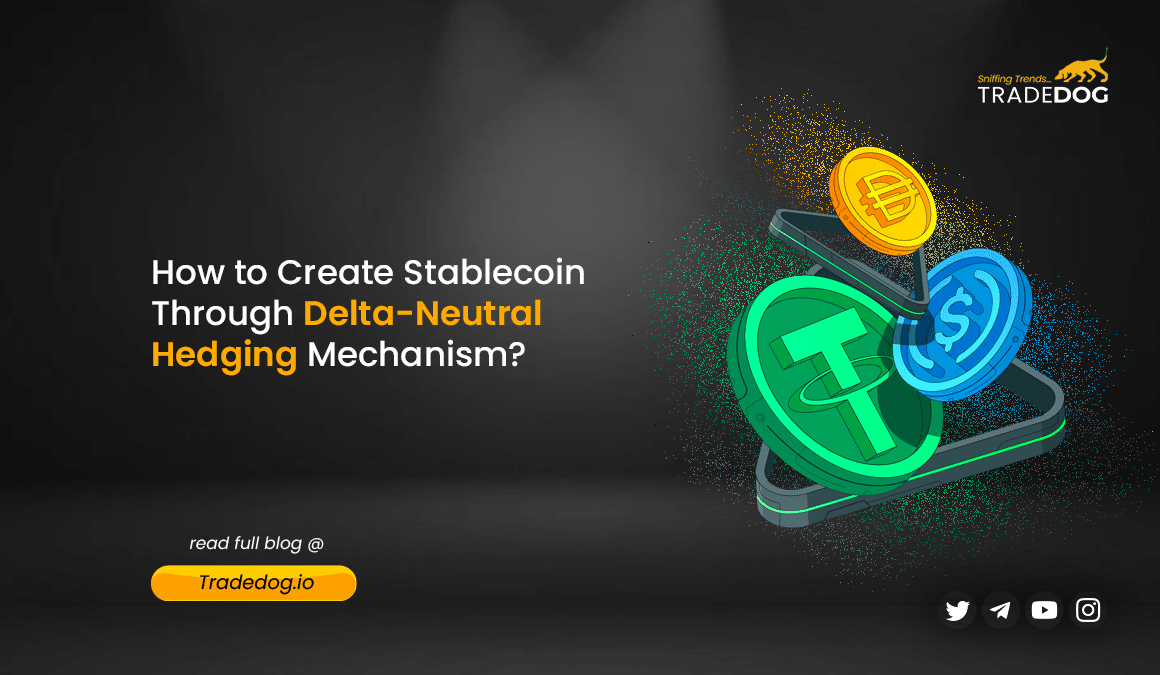Quick Links
Stablecoins have been the crypto industry’s financial instrument, witnessing significant adoption and innovation. With the total circulation of stablecoins now valued at approximately $150 billion, they have been a pivotal factor in simplifying the investment journey of institutions and investors.
In terms of innovation, we have seen many methods, quite distinctive from each other, leading to the formation of stablecoins. From backing its value and stability with real-world assets like treasury bills to creating an algorithmic process of minting and burning, we have witnessed that this particular type of cryptocurrency brings both stability and disruption (depegging) at the same time.
Note: This article is completely inspired by Ethena and its synthetic dollar called USDe.
The Problem Statement
The superior offering of cryptocurrencies revolves around decentralization. However, this industry has faced multiple instances of centralization, leading to dramatic consequences, including misuse of user funds, exploits, thefts, and much more. Leading stablecoins like Tether (USDT) and USDC, with significant market shares, are much more reliant on TradeFi instruments.
The above graph suggests that the reserves backing the value and stability of USDT consist of US treasury bills (75.9%), overnight reverse repo rate (12.10%), money market funds (11.10%), and others, including cash & bank deposits and term reserve repo. In the case of USDC, its reserves mostly consist of overnight reverse repo rate (67.30%), US treasury bills (19.80%), money market funds (3.30%), and cash & bank deposits (9.70%).
Now, the problem statement does not involve TradeFi assets being a significant part of leading stablecoins’ reserves but the economic factors associated with it. This suggests that any negative economic factor affecting traditional markets, including equity and bonds, can have the same effect on cryptocurrencies. In this particular manner, the foundation of cryptocurrencies in terms of decentralization gets skeptical.
We have also witnessed multiple attempts in terms of innovation introduced for the creation of stablecoins while removing the dependency on TradeFi assets. One of the prominent examples includes algorithmic stablecoins which consists of the process of burning and minting a cryptocurrency backing the value and stability of a stablecoin. For example, DAI maintains its value close to one US dollar through smart contracts that lock up collateral (like Ethereum) on the blockchain. This allows users to borrow DAI against their crypto assets, ensuring stability and over-collateralization to minimize volatility.
However, algorithmic stablecoins have also faced vulnerability in the past in terms of depegging, where the whole mechanism backing their value close to one dollar gets exploited. Taking the case of UST, it got depegged from the US dollar when a mass sell-off led to a loss of confidence, overwhelming the algorithmic mechanism designed to maintain its peg by balancing supply and demand, which ultimately caused its value to plummet.
Having said that, it won’t be completely wrong to conclude that stablecoins haven’t truly discovered the decentralized mechanism that can back their peg. However, recently, I have come across an interesting solution that might be able to address this significant problem for stablecoins.
A Delta-Neutral Stablecoin
The aim here is to create a synthetic dollar that is not reliant on traditional banking system infrastructure and become a stable crypto-native solution through delta-hedging collateral.
For those beginning their journey in the crypto industry and just came across this article, let me simplify what delta-neutral hedging is. And for those who already know about it, you can skip the below paragraph.
Delta-neutral hedging is a kind of trading strategy that involves setting up positions to offset the directional risk of a portfolio, aiming to make the portfolio’s value unaffected by small price movements in the underlying assets. For example, I had invested in Bitcoin at the price level of $50,000 and in the long run, I am expecting it to touch $90,000. However, my short-term prediction suggests that it may face a price correction to the level of $40,000. In such a case, I will take a long position in the spot markets while hedging the potential risk while taking a short position. In this particular manner, I have adopted a delta-neutral hedging strategy.
Creating a stablecoin based on this strategy can be done via hedging the delta of spot assets backing the token during the minting process, which can ensure stability, scalability, and censorship resistance. This process involves minting the stablecoin against a backdrop of collateral, typically staked Ethereum, which is then hedged via derivatives to maintain a stable value equivalent to a synthetic USD.
Source: Ethena Labs
The key to this approach is the use of derivatives for capital efficiency. This allows for 1:1 collateralization by matching the staked collateral with a corresponding short position of equal notional value. Stability is ensured through immediate hedges against the transferred assets upon issuance, safeguarding the synthetic dollar’s value across market conditions.
This method not only addresses issues of stability and scalability but also offers an uncensorable yield-generating asset, thereby providing a robust foundation for the stablecoin without relying on the conventional banking system. Now, the common questions that arise from this method include the following:
Why Do We Need to Hedge?
The peg stability mechanism for a stablecoin ensures value remains constant by using delta-hedging. This involves taking positions in derivatives that balance out any profit or loss from changes in the value of the collateral assets deposited by users. In essence, it automatically adjusts to keep the stablecoin’s value stable, regardless of fluctuations in the collateral’s value.
How we can ensure every asset minted is delta-neutral?
This can be achieved by taking opposite positions in derivatives to balance the impact of price changes on the users’ deposited collateral. This means that any gains or losses in the value of the collateral are counteracted by the derivatives positions, keeping the overall value stable and creating a “synthetic stable dollar.” The issuer does not use borrowed money for such operations, which also eliminates the risk of having to sell assets (liquidation) due to changes in the value of the collateral or derivatives. The stablecoin is not given to users until it’s confirmed that these balancing positions are successfully in place.
How does the Issuer manage delta-hedging?
The system operates non-stop to maintain balance in the value of assets, grouping and offsetting requests to create or destroy stablecoin units whenever feasible. To ensure the most efficient transactions, several factors are considered:
- Synthetic price involves calculating an asset’s true value, including adjustments for any temporary overvaluation or undervaluation in its trading price.
- Funding rate involves adjusting the calculated price based on expected returns, factoring both current and past funding rates and the premium for futures contracts specific to the provider.
- Risk limits involve managing the portfolio to ensure a balanced exposure across trading platforms, with limits on how much any single platform can contribute to the overall risk.
Transactions to adjust the portfolio are spread out across various exchanges to minimize market impact and ensure high-quality execution. An integrated order book that accounts for price adjustments helps in identifying the best places to find liquidity and execute trades efficiently.
When sourcing liquidity from different sources, the timing differences (latencies) between the system and each trading venue are carefully managed to ensure that trades are executed simultaneously across venues. For large requests that cannot be immediately matched within a very tight price range of the fair value, a manual process is used. This involves executing the trade at a price determined by averaging over time, plus an additional margin for risk.
Key Considerations of Delta-Neutral Stablecoin
We are still behind when it comes to forming a complete decentralized system for the creation of stablecoin. In the case of stablecoin created through a delta-neutral hedging mechanism, the following are some considerations that might need your attention:
Funding Payments/Costs
The protocol for receiving or paying funding might cause the portfolio to deviate from within the accepted delta neutrality boundaries. For this, the protocol can employ continuous monitoring and adjustments to maintain a balance in its positions, especially when handling funding payments or costs that could disrupt this balance. These adjustments are done in real time through additional hedging actions.
Exchange Failure
In the event of an exchange failure, it could lead to a moment wherein the system delta is not hedged as the positions on the exchange no longer exist, though in some cases the PnL may be recoverable. In such cases, the protocol swiftly shifts its hedging activities to other exchanges using the available collateral. The initial lack of borrowing (leverage) allows for this flexible response without the risk of forced liquidations.
Hedges using Inverse (coin-margined) contracts
When you hedge using contracts that are backed by the same type of cryptocurrency as the asset you’re trying to protect, the hedge’s effectiveness stays pretty steady, only slightly increasing or decreasing as the asset’s price changes. However, if the asset’s price moves quickly, the value of what you’re using as collateral for these hedges can change rapidly, making the hedge less predictable. This situation requires adjusting the hedge to keep everything balanced and within safe limits.
Analyst Remark
In my opinion, the method of creating a stablecoin through a delta-neutral hedging mechanism definitely brings a new innovation to the table. However, its significant reliance on market conditions and related dynamics might make it prone to unwanted circumstances of depegging. A carefully designed architecture of continuous monitoring and adjustments might be able to deliver the required balancing for maintaining the stablecoin’s peg.
Having said that, the act of making adjustments and monitoring the market conditions is completely in the hands of the issuer (atleast during the initial phase). Additionally, the hedging strategies build more reliance on centralized exchanges as the decentralized derivatives market is yet to reach the level of mass adoption, with CeFi open interest being 25 times higher than DeFi open interest.
As onchain DEXes matures, we can expect this whole system using solely decentralized venues to execute the hedge in order to be fully decentralized.
The waters will also be tested when Ethena’s USDe have traded through a complete market cycle consisting of different conditions and volatility. If the cycle is passed without any incidents related to depegging, we might have a new verified mechanism for the creation of stablecoins. At the time of writing, USDe market cap stood at $882 million which is far behind as compared to the market cap of its leader (USDT) of the category at around $102 billion.









